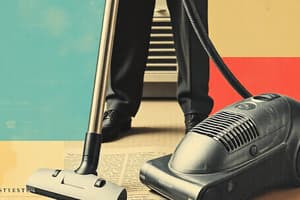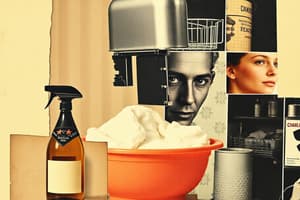Podcast
Questions and Answers
What is the primary responsibility of the Executive Housekeeper?
What is the primary responsibility of the Executive Housekeeper?
- To develop new cleaning products
- To ensure HK staff follow standard cleaning procedures (correct)
- To perform all cleaning tasks personally
- To supervise guest services
Which cleaning method is recommended for surfaces that are sticky or dirty?
Which cleaning method is recommended for surfaces that are sticky or dirty?
- Sweeping
- Vacuuming
- Dry dusting
- Damp dusting (correct)
Which method should be avoided when cleaning electrical and electronic equipment?
Which method should be avoided when cleaning electrical and electronic equipment?
- Damp dusting (correct)
- Sweeping
- Washing
- Dusting
What is a key consideration in selecting cleaning procedures for carpets and floors?
What is a key consideration in selecting cleaning procedures for carpets and floors?
What is the most effective way to fold a duster for maximum efficiency?
What is the most effective way to fold a duster for maximum efficiency?
Which of the following cleaning methods does NOT require mechanized equipment?
Which of the following cleaning methods does NOT require mechanized equipment?
What is necessary to maintain the correct temperature during cleaning?
What is necessary to maintain the correct temperature during cleaning?
Which factor is NOT required for effective cleaning in housekeeping?
Which factor is NOT required for effective cleaning in housekeeping?
What is a primary reason for regular cleaning in an environment?
What is a primary reason for regular cleaning in an environment?
Which of the following accurately defines 'tarnish'?
Which of the following accurately defines 'tarnish'?
What should be done first in the cleaning process according to the principles of cleaning?
What should be done first in the cleaning process according to the principles of cleaning?
Which principle emphasizes the order of cleaning tasks?
Which principle emphasizes the order of cleaning tasks?
What is classified as 'foreign matter' in the context of cleaning?
What is classified as 'foreign matter' in the context of cleaning?
What should be done immediately after a stain occurs according to the cleaning principles?
What should be done immediately after a stain occurs according to the cleaning principles?
Which of the following is a recommended practice regarding the use of cleaning agents?
Which of the following is a recommended practice regarding the use of cleaning agents?
What is the best description of 'dust' as defined in cleaning terminology?
What is the best description of 'dust' as defined in cleaning terminology?
What is the primary purpose of dust mopping?
What is the primary purpose of dust mopping?
What should be avoided when spot mopping?
What should be avoided when spot mopping?
Which step must be completed before wet mopping?
Which step must be completed before wet mopping?
How should the mop be moved when dust mopping?
How should the mop be moved when dust mopping?
What type of solution can be used during dust mopping to control dust?
What type of solution can be used during dust mopping to control dust?
What is a precaution to take when spot mopping?
What is a precaution to take when spot mopping?
What is the role of the detergent in wet mopping?
What is the role of the detergent in wet mopping?
What should be done with the mop head after finishing the mopping process?
What should be done with the mop head after finishing the mopping process?
What is the primary goal of suction cleaning?
What is the primary goal of suction cleaning?
Which of the following is NOT a step in manual scrubbing?
Which of the following is NOT a step in manual scrubbing?
What equipment is necessary for manual polishing?
What equipment is necessary for manual polishing?
During manual scrubbing, what should be done after rinsing?
During manual scrubbing, what should be done after rinsing?
What type of machines are commonly used for suction cleaning?
What type of machines are commonly used for suction cleaning?
What is the correct method to clean room corners during suction cleaning?
What is the correct method to clean room corners during suction cleaning?
Which of the following best describes the process of manual polishing?
Which of the following best describes the process of manual polishing?
What should be used to enhance the cleaning of carved articles during manual polishing?
What should be used to enhance the cleaning of carved articles during manual polishing?
What is the primary purpose of spray buffing?
What is the primary purpose of spray buffing?
Which piece of equipment is essential for the scrubbing process?
Which piece of equipment is essential for the scrubbing process?
What distinguishes heavy scrubbing from light scrubbing?
What distinguishes heavy scrubbing from light scrubbing?
Which characteristic is common to dry cleaning?
Which characteristic is common to dry cleaning?
What is a follow-up step recommended after both spray buffing and polishing?
What is a follow-up step recommended after both spray buffing and polishing?
Which RPM range is associated with the use of a floor machine for scrubbing?
Which RPM range is associated with the use of a floor machine for scrubbing?
Which of the following can be a result of aggressive scrubbing?
Which of the following can be a result of aggressive scrubbing?
What type of cleaning process is described by removing soil and stains from textiles without water?
What type of cleaning process is described by removing soil and stains from textiles without water?
Flashcards are hidden until you start studying
Study Notes
Cleaning
- Cleaning is the process of removing dust, dirt, foreign matter, tarnish, and stains from various surfaces using cleaning agents and equipment.
- Cleaning is essential for aesthetic appeal, hygiene, maintenance, and safety.
- Soil refers to deposits of dust, dirt, foreign matter, tarnish, and stains.
Principles of Cleaning
- Soil should be removed without harming the surface being cleaned.
- Cleaning should be efficient using minimal equipment, cleaning agents, labor, and time.
- Cleaning should proceed from high to low.
- Suction cleaning should be preferred over sweeping whenever possible.
- Sweeping should be done before dusting, and dusting before suction cleaning.
- Noise levels while cleaning should be kept as low as possible.
- Stains should be removed as soon as they occur.
- Room attendants should take all safety precautions while cleaning.
- Cleaning agents and equipment should be stocked neatly to one side.
- All equipment should be cleaned, dried, and stored properly after use.
Cleaning Considerations
- Time: The duration of the cleaning job.
- Temperature: Correct temperature must be maintained for the specific cleaning task.
- Mechanical action: The force or friction required to complete the cleaning task.
- Chemical action: The power of chemicals used in the cleaning process.
- Procedures: Following the correct cleaning and sanitizing procedures.
Housekeeping and Cleaning Procedures
- The Executive Housekeeper is responsible for ensuring that housekeeping staff follow standard cleaning procedures and methods.
- Floors and carpets require regular cleaning to maintain their appearance and durability.
- Cleaning processes can be manual or mechanical, using methods such as washing, friction, static electricity, suction, or force.
Manual Cleaning Methods
- Sweeping is used to collect dust from rough surfaces.
- Dusting requires a systematic approach using a soft, lint-free cloth folded multiple times.
- Damp dusting is preferred in hotels as it removes dust, dirt, and sticky marks but should be avoided on electrical and electronic equipment.
- Floor dust mopping is used to remove dust, sand, or grit from the floor.
- Spot mopping is used to clean spills and adhered soil, using cold water and detergent only when necessary.
- Wet mopping is used to remove light to heavy soil from the floor surface after dust mopping.
- Manual scrubbing is used to remove stubborn dirt and marks on floor surfaces.
- Manual polishing is used to apply polish to surfaces like floors, furniture, and metal objects.
Mechanized Cleaning Methods
- Suction cleaning or vacuum cleaning is a preparatory step to other mechanized cleaning procedures.
- Spray buffing uses a floor machine and a soft pad or brush to remove soil, scuffs, scratches, and restore shine.
- Polishing uses a floor machine and a soft pad or brush to remove soil and restore shine to the floor finish.
- Scrubbing uses a floor machine with a pad or brush to remove embedded dirt, marks, and scratches.
- Dry cleaning is used to remove soil and stains from textiles using a chemical solvent other than water.
Equipment and Agents
- Damp dusting: Cloth duster, water, plastic bowl, neutral detergent (if necessary).
- Floor dust mopping: Dust control mop.
- Spot mopping: Damp cloth, cold water, detergent (if necessary).
- Wet mopping: Damp mop, water, neutral or mild alkaline detergent.
- Manual scrubbing: Long-handled scrubbing brush, mild detergent, bucket, squeegee, water, and mop.
- Manual polishing: Proprietary polish for each surface, cotton rags, soft brush (for carved articles).
- Suction cleaning: Vacuum cleaner.
- Spray buffing: 175- or 300-rpm floor machine, soft pad or brush, commercial cleaning preparation or detergent, finishing solution.
- Polishing: 175- 1500-rpm floor machine, soft pad or brush.
- Scrubbing: 1500 – 2500 rpm floor machine.
- Dry cleaning: Chemical solvents, dry cleaning machine.
Studying That Suits You
Use AI to generate personalized quizzes and flashcards to suit your learning preferences.




